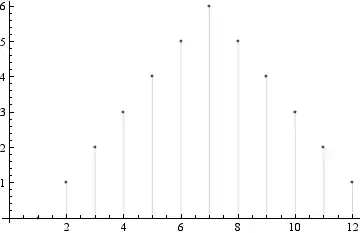I'm toying around with the idea of designing a board game. I like the idea of a hexagon-tile setup (a la Catan). There would be some number of different resource categories; I'm trying to determine how many. Each tile would have a number from 1 to 6 associated with each resource category, representing the number you'd have to meet or beat when rolling a D6 to acquire that resource. And you'd get one die roll per resource type. In the interest of fairness, I'd like each tile to have the same total value -- probably the floor of the expected roll value times the number of different resources.
So, for example, if I only had one resource type (let's call it Resource A), then I'd want each tile to have a total value of 3, which trivially means that I'd have one unique type of tile, which had a value of 3 for Resource A. One die rolls that value in exactly one way.
If I had two resource types, Resource A and Resource B, then I'd want the total value of each tile to be 7. Brute-forcing it, I know that there are 6 different permutations of 2D6 rolls that add up to 7 (1 & 6, 2 & 5, 3 & 4, 4 & 3, 5 & 2, 6 & 1). So in that case, I'd have 6 unique types of tiles. But what if I wanted three resource types, with a total value of 10? Or four dice rolls, with a total of 14?
So I'm wondering, what is the formula for generalizing this? Specifically, the number of permutations for which n dice will add up to a total m. And explain it like I'm simple -- it's been a long while since I've done this kind of math. I'm curious for my own enrichment, as well as the (theoretically) practical application of determining how many unique tiles I could potentially include.
